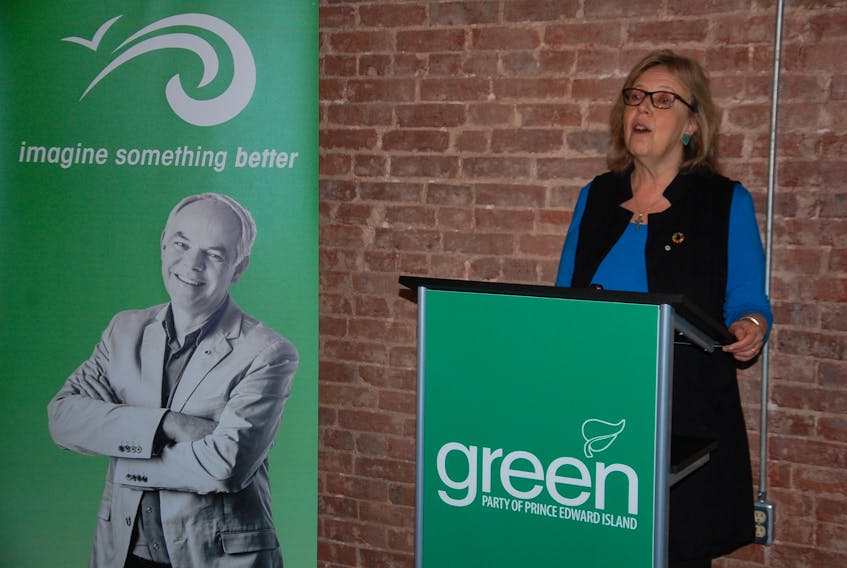
Maybe it’s not easy being Green because of all the policy you have to learn.
Interest in the Green Party is reaching new heights across Canada — one recent poll found as many as four in 10 Canadians would at least consider voting Green in this fall’s election — so it might be nice to know where the Greens stand on issues beyond the environment.
When Canadian Greens protest that they are more than a one-issue party, they know of what they speak. This is a political party that thinks a lot about a lot and has the audacity to write it all down in a policy epic called Vision Green.
The paper claims that people have trouble positioning the Canadian Greens on the old political spectrum. That may hold true for people who haven’t read the Green policy tome, but those who have, can locate the party. It’s out there on the left, and no amount of talk about fiscal probity will change that.
For their part, the Greens want only to be known as the party of the future.
The Green Party of Canada likes small business but is deeply suspicious of big corporations that, it says, should pay more and higher taxes. The party checks all the right boxes for public, universal health care and wants more emphasis on disease prevention. It slides comfortably into the pro-immigration slot of the left, advocates global nuclear disarmament and waxes as eloquently about eliminating poverty as it does about saving the planet.
Perhaps it’s a function of membership in a global political movement — there are Green parties in 70 countries — that prompts the Canadian Greens to stake out more foreign policy than the traditional parties would deem prudent. Policies, after all, are something every party must have, but most take care not to present easy targets for their opponents. Not the Greens. They put it all out there for everyone, with the time and inclination, to see.
The Greens proudly trace their roots back to the 1960s counter-culture — “the first mass rejection of consumer culture” — and the ’60s values the Greens remember — peace, love and understanding — have become the founding Green Party values of non-violence, social justice and ecological thinking.
Party leader Elizabeth May, in her introduction to the policy compendium, which comes in six parts, some of which have more than 20 sub-sections, says Vision Green is the product of more than a decade of research, discussion and revision. The result is a vast warehouse of policy considerations ranging from a position on Iran — they want open dialogue aimed at bringing that country back into the family of nations — to an assault on sugary drinks.
It is, of course, a fool’s errand to try, in one brief newspaper column, to do justice to more than 80 detailed policy pronouncements and the evidence that supports each one. A few highlights, however, can point to the general direction.
The Green tax policy, for example, is pretty straightforward. They will tax the stuffing out of stuff that does harm — pollution tops the list — and cut taxes on those things we want to encourage, like income and employment.
Much of the party’s economic policy is connected to the transition of fossil fuels to renewable forms of energy, and on putting in place the social supports required to end poverty in Canada.
Indeed, Canada’s Green Party effectively connects the dots from the nation’s shameful poverty rates and the entrenched inequities that impose economic penalties on women, visible minorities and Canadians living with disabilities, to the full slate of social ills, as well as to high costs in the health and justice systems.
It wants an affordable, national child-care program; believes tuition-free post-secondary education should be the goal but will settle for more generous student loan provisions in the near term; and wants to make decent housing a fundamental right of Canadians by putting it in the Charter.
Like all political parties, the Greens pay the necessary patriotic homage to Canada as the greatest nation on Earth, but they don’t shy away from the great national disgrace “found in the profound inequality of life on First Nations Reserves and life for off-reserve urban Aboriginal people across Canada.”
If you’re not tempted by nostalgia for the great rock music, social upheaval and tie-dyed leisure wear of the 1960s, the Greens also want to modernize Canada’s arcane first-past-the-post electoral system with a form of proportional representation. They also claim to reject the parliamentary custom of voting the party line in favour of individual MPs having the freedom to reflect the wishes of their constituents.
The Greens haven’t got all the answers, but they don’t hide from the questions. They even offer a detailed plan to support the arts and culture.
“Shouldn’t at least one political party speak in praise of beauty?” the party asks.
Yes, it should.
RELATED:









